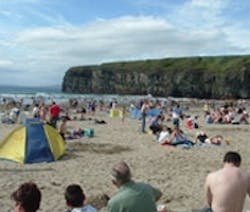More Swimmers Means More Pathogens in the Water
The levels of potentially harmful waterborne microorganisms in rivers, lakes and other recreational waterways may be highest when the water is most crowded with swimmers. Researchers at the Johns Hopkins Bloomberg School of Public Health completed two studies at the Hammerman beach area along Maryland’s Gunpowder River that linked the number of swimmers using the water with the levels of microsporidian spores and the parasites Cryptosporidium parvum and Giardia lamblia. The studies were made available online in advance of publication in the scientific journals Applied and Environmental Microbiology and Water Research.
Exposure to microorganisms like C. parvum and G. lamblia can cause nausea, vomiting and diarrhea. They can be particularly harmful to people with compromised immunity.
“Our research suggests it would be best to test the water when the beach is active to determine if it is safe for recreational use,” said Thaddeus K. Graczyk, PhD, co-author of both studies and associate professor with the Bloomberg School’s Department of Environmental Health Sciences and Center for Water and Health. According to Graczyk, health officials typically conduct water sampling when there is little human activity.
For both studies, researchers sampled the water at the Hammerman area for 11 weeks during the summer of 2006. Samples were taken on Wednesdays, when beach activity was typically low, and on Saturdays, when activity was usually high. The researchers also counted the number of swimmers in the water at the time the water was sampled.
The concentration of microsporidian spores, C. parvum and G. lamblia were highest during the weekends, when the beach was busiest. Water turbidity was also highest on the weekends. The findings indicate that the swimmers stir up pathogens resting in the sediment.
The Environmental Protection Agency does not require testing for microsporidian spores, C. parvum or G. lamblia in recreational waters, because of the cost and difficulty in measuring these pathogens. Regulations do require that water be tested for E. coli and enterococci as bacterial indicators of fecal contamination.
“Monitoring for E. coli and enterococci may not be reliable in monitoring for waterborne protozoan pathogens,” said Graczyk.
“A quantitative evaluation of the impact of bather density on levels of human-virulent microsporidian spores in recreational water,” was written by Thaddeus K. Graczyk, Deirdre Sunderland, Leena Tamanga, Timothy M. Shields, Frances E. Lucy and Patrick Breysse. It is published in Applied and Environmental Microbiology.
“Impact of bathers on levels of Cryptosporidium parvum oocycts and Giardia lamblia cycts in recreational beach waters” was written by Deirdre Sunderland, Thaddeus K. Graczyk, Leena Tamanga and Patrick Breysse. It is published Water Research.
All authors are with the Johns Hopkins Bloomberg School of Public Health, except Lucy, who is with the School of Science Institute of Technology in Sligo, Ireland.
Funding for the research was provided by the Fulbright Senior Specialist Fellowship, Johns Hopkins NIEHS Center for Urban Environmental Health, Johns Hopkins Faculty Research Innovation Fund, Johns Hopkins Center for a Livable Future and the University of the District of Columbia.
Source: Johns Hopkins Bloomberg School of Public Health
